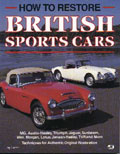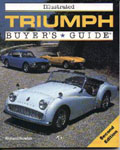|
1962 Triumph TR4 Restoration |
|
Brian Sanborn, Groton, MA |
Inspecting the Car
Regardless of category, inspecting the car carefully is very important. There are lots of good sources for advice
and a detailed "how-to" on inspecting Triumphs. Try "How To Restore British Sports
Cars" by Jay Lamm and
Try "How To Restore British Sports
Cars" by Jay Lamm and  the "Illustrated Triumph Buyers Guide" by Richard
Newton. And for a sample TR4 checklist try this Inspection
Checklist which I worked up for my TR4 based on the original list on the autox.team.net website.
the "Illustrated Triumph Buyers Guide" by Richard
Newton. And for a sample TR4 checklist try this Inspection
Checklist which I worked up for my TR4 based on the original list on the autox.team.net website.
Come prepared with the right tools. On all of my TR4 search trips, I took along a toolbox with a basic set of automotive
hand tools, a 1/4 and 3/8 socket set, one of those small hydraulic floor jacks, a volt/ohm meter, compression tester,
powerful flashlight, a creeper and lots of rags.
Plan so you arrive with plenty of daylight. See if you can get the car into some shade with a hard surface underneath.
Do a first pass walk-around. Use the inspection checklist to go through each system of the car. Do a very thorough
inspection of the frame and body for rust before you try to do anything else. Almost any 36+ year old car will
have some rust. Check all the most likely places. If you're really lucky, like I was, you will find a gem from
San Francisco with no rust at all. But always check for bondo in the bodywork with a small strong magnet. Don't
start the engine until you get to that point in the checklist. Save the test drive for last. Try to stay objective
and patiently run the checklist.
If the car is a daily driver or above, you should be looking for evidence that the car is driven regularly and
ask to see receipts for restoration and maintenance work that has been done or new parts that are claimed. No one
should take offense to this request. Ask that they be available when you come to see the car. Also ask about any
"spares" that come with the car.
Some of the must-do things are checking the engine compression. It can tell you a lot about general engine condition.
Look for consistent readings cylinder to cylinder. Pressure reading should be within 5-10% of each other and a
rebuilt engine should read at or above 155 lbs. dry.
Check the oil pressure at cold startup and more importantly when the oil comes to full operating temperature. Depending
on weather that takes about 15-20 minutes of driving. The oil pressure at 900 RPMs should be at least 35 pounds
and at 70+ above 2500 RPMs. Anything else is a sign of trouble. Worn bearings are the most likely source of low
oil pressure. A full engine rebuild will cost about $2,300 in parts and shop work even if you do it yourself. A
proper British car specialist will charge as much as $3,500.
Listen to the transmission noises carefully during the test drive. You can hear all the car noises better if you
put up the hood (top in US English) for the test drive. Any unusual noises of any kind, difficult shifting or jumping
out of gear are signs of a possible gearbox rebuild in the very near future. Bring up the RPMs in neutral with
the clutch out to listen for throw-out bearing noises. Test the clutch for slipping or chattering. A rebuilt gearbox
will cost about about $900 with your gearbox as an exchange. You can rebuild a gearbox to almost new for about
$250 in parts if you do the job yourself. I would rate the job has a little more involved than the engine rebuild
but can be done with the step-by-step instructions in a Haynes Manual.
And the most important rule is, unless you have found a rare jewel don't make any buy decisions until you get home.
Think the whole thing out on the way home in the car. You would be surprised how the emotion you develop during
the inspection can do crazy things to your judgment. If you still want the car call up and make an offer. And stick
to it until you find the right car for you. Don't jump on the first or second car out of enthusiasm or frustration.
It may take 2 months or it might take a year to find the right TR. And the looking will educate you. You find yourself
refining what you want based on all the trips to look at cars.